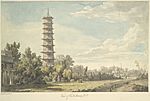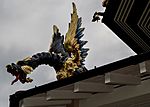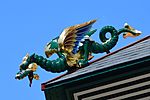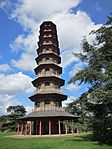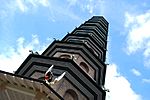Great Pagoda, Kew Gardens facts for kids
Quick facts for kids Great Pagoda |
|
|---|---|
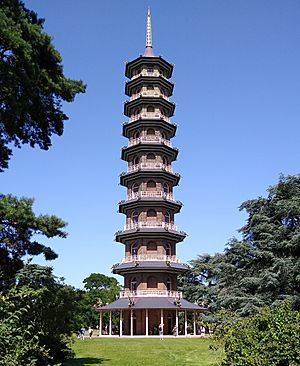
"This supreme example of Chinoiserie"
|
|
| Type | Pagoda |
| Location | Kew Gardens, London |
| Height | 163 ft (50 m) |
| Built | 1761 |
| Restored | 2018 |
| Restored by | Austin-Smith:Lord |
| Current use | Museum |
| Architect | Sir William Chambers |
| Architectural style(s) | Chinoiserie |
| Governing body | Historic Royal Palaces |
|
Listed Building – Grade I
|
|
| Official name: The Pagoda | |
| Designated | 10 January 1950 |
| Reference no. | 1262593 |
| Lua error in Module:Location_map at line 420: attempt to index field 'wikibase' (a nil value). | |
The Great Pagoda is a famous building located in Kew Gardens in southwest London. It was built in 1761 by Sir William Chambers. He designed it as a special gift for Princess Augusta, who started Kew Gardens.
This amazing pagoda is made of grey bricks and has 10 floors. It stands about 163 feet (50 meters) tall. There are 253 steps inside that lead up to a viewing area. The pagoda was closed for repairs in 2006. After a big restoration project, it reopened in 2018. Today, it is a very important historic building, known as a Grade I listed building.
The ground floor roof of the pagoda rests on wooden pillars. The floors above it have balconies with a special Chinese-inspired design. These balconies feature curved roofs. The roofs are now covered in lead. However, they were originally decorated with green and white tiles. Eighty restored dragons sit on top of each roof. Experts describe the pagoda as a top example of chinoiserie. This is a European art style that uses Chinese designs. A study in 2019 called it "the most important surviving chinoiserie building in Europe."
Contents
History of the Great Pagoda
Princess Augusta was the wife of Frederick, Prince of Wales. She started the botanic garden at Kew in 1759. Princess Augusta hired Sir William Chambers to build several structures in the gardens. These included temples, a ruined arch, and the Great Pagoda.
The 1700s saw a big increase in trade between China and Western countries. This led to a huge interest in Chinese art and culture. Chambers' pagoda was one of the first buildings to show this new interest. Sir William Chambers was born in Sweden but grew up in England. He traveled to China and Bengal three times in the 1740s. These trips helped him learn about Chinese architecture.
Later in his life, Chambers wrote books about Chinese design. One book was called Designs of Chinese Buildings, published in 1757. He also wrote A Dissertation on Oriental Gardening. When he first saw the gardens at Kew, he wasn't very impressed. He described them as "not large" and said the soil was "barren."
Chambers was mainly a Palladian architect. This style was based on ancient Roman architecture. He wrote that the style of Palladio was "correct and elegant." However, he was also happy to use Chinese designs. He saw these designs as "toys" that were good for garden decorations.
Chambers explained his inspiration for the pagoda in his book, The Gardens and Buildings at Kew in Surry (1763). He said the design was an imitation of Chinese Taa. He had already designed another Chinese-style building at Kew called The House of Confucius.
A study in 2013 looked at possible Chinese buildings that inspired the Great Pagoda. Unlike most architects of his time, Chambers had actually visited China. This meant he had seen many different Chinese buildings. The study suggested the Porcelain Tower of Nanjing as a possible inspiration. However, it pointed to two pagodas in Guangzhou, China, as more likely sources. These were the Chigang Pagoda and the Pazhou Pagoda. Both were built in the early 1600s, and Chambers likely saw them during his travels.
Building the Pagoda Quickly
The Great Pagoda was built very quickly, in only six months. Chambers was proud of how fast it was built and how well it was made. He said the walls were made of "very hard bricks." He also noted that there were no cracks in the structure, even though it was built so fast and was very tall.
Originally, 80 gilded (gold-covered) dragons decorated the roofs of the ten floors. However, these dragons were removed by 1784. The pagoda's height amazed people at the time. In 1762, writer Horace Walpole wrote that the pagoda would soon be visible from far away.
Restoring the Pagoda
During the Second World War, the pagoda was used for testing. Holes were made through each floor to drop smoke bombs from the top. By the late 1900s, the pagoda was in poor condition and closed to visitors.
A big restoration project began, led by the Royal Botanic Gardens, Kew, and Historic Royal Palaces. The goal was to bring the pagoda back to its original look. This included carving new dragons and putting them back on the roofs. The pagoda reopened in 2018.
To make the new dragons, a master copy was carved from African cedar wood. Seven more wooden dragons were made for the lowest roof. The rest of the dragons were made from nylon using 3D modelling technology. This was because wooden sculptures would have been too heavy for the upper roofs. The restoration project has won several design awards.
Gallery
See also
- Pagoda of Chanteloup Château


